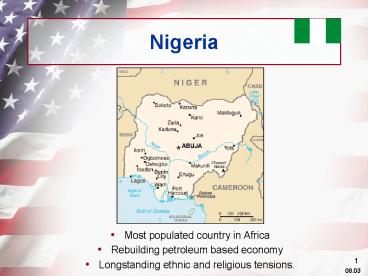Nigeria - PowerPoint PPT Presentation
1 / 7
Title:
Nigeria
Description:
Microbial and chemical contamination of local agricultural products. ... particulates, chemicals from soil, pesticides, fertilizers, and fecal pathogens. ... – PowerPoint PPT presentation
Number of Views:26
Avg rating:3.0/5.0
Title: Nigeria
1
Nigeria
- Most populated country in Africa
- Rebuilding petroleum based economy
- Longstanding ethnic and religious tensions.
2
Nigeria Environmental Issues
- Topography
- Climate
Climate varies equatorial in south, tropical in
center, arid in north.
Terrain Southern lowlands merge into central
hills and plateaus mountains in southeast,
plains in north.
Lowest point Atlantic Ocean 0 m Highest point
Chappal Waddi 2,419 m
3
Nigeria Environmental Issues
- Air
- Low risk
- On-site disposal of gas by burning may lead to
localized air contamination around oil and gas
industry. - Some pollution near specific industrial and urban
areas. - Soil
- Low risk but should be avoided when possible.
- Sabotage of petroleum pipelines has led to some
soil pollution in Nigeria - Soil contamination near industrial facilities and
waste disposal sites. - Significant exposure unlikely in the absence of
wind, active digging, or leakage into ground
water.
4
Nigeria Environmental Issues
- Food
- Microbial and chemical contamination of local
agricultural products. - Food may also be contaminated with industrial
particulates, chemicals from soil, pesticides,
fertilizers, and fecal pathogens. - Water
- Raw sewage primary water contaminant.
- In southern Nigeria, dumping of untreated
industrial wastes (heavy metals, petroleum,
fertilizer. - Petroleum spills.
5
Nigeria Environmental Issues
- Greatest short-term environmental health risks
- Water contaminated with raw sewage
- Runoff containing fecal pathogens,
- Air contamination from flaring of natural gas.
6
Nigeria Diseases of Operational Importance
- Highest risk country
- Diseases of greatest risk
- Food and Waterborne Diseases Bacterial diarrhea,
Hepatitis A, Protozoal diarrhea and
Typhoid/paratyphoid fever - Vector-borne Diseases Malaria
- Sexually Transmitted Diseases HIV/AIDS,
Hepatitis B. - Soil Contact Diseases Lassa Fever
- Respiratory Diseases Meningococcal meningitis
7
Nigeria Diseases of Operational Importance
- Diseases of potential risk
- Food and waterborne Diseases Brucellosis,Cholera,
Hepatitis E - Vector-borne Diseases Boutonneuse fever
(Mediterranean spotted fever), Chikungunya,
Crimean-Congo hemorrhagic fever, Dengue fever,
Leishmaniasis, Rift Valley fever, Sindbis
(Ockelbo) virus, Gambiense trypanosomiasis
(African), Murine typhus (flea-borne), West Nile
fever and Yellow fever - Sexually Transmitted Diseases Gonorrhea and
Chlamydia. - Water-contact Diseases Leptospirosis,
Schistosomiasis - Respiratory Diseases Tuberculosis
- Animal-contact Anthrax, Q-Fever and Rabies































